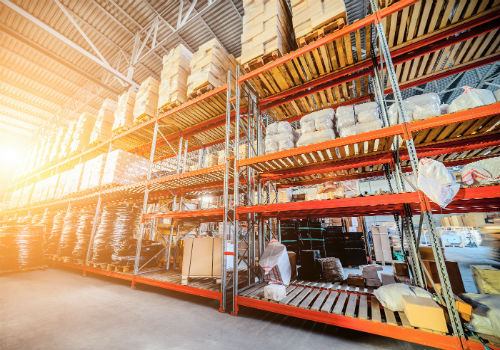There are many ways to expand your warehouse’s storing capacity without increasing the physical size of the facility. While heavy-duty shelving helps, there are several simple ways to ensure you can store excess goods and still be able to move around your warehouse comfortably and safely.
When pallet movement is restricted, efficiency is as well. To avoid this loss in productivity, warehouse operators should make simple adjustments to the organization and layout of their facility.

Here are a few suggestions that can help maximize space and expand storage capacity in your warehouse:
1. Use Industrial Shelving
Some businesses choose not to use industrial shelving, and instead, they stack their pallets vertically on the warehouse floor. The benefit of this system is that there are no shelving costs. The downside is less organization and less efficiency in vertical areas. Industrial shelving keeps your inventory safely organized and maximizes vertical efficiency.
Systems such as wire shelving and pallet racking not only increase your storage capacity, but they also help with the safety of the building. Having an unorganized storage space can be detrimental to safety. Employees need to be able to walk around the warehouse and easily and safely locate merchandise, and the best way to do that is with a good racking system.
2. Utilize Vertical Space
With most warehouse racking systems, utilizing vertical space is simple. When floor space is gone, the most efficient way to increase storage capacity is to build upwards.
You must consider the weight of the items that will be loaded, stored, and later unloaded from the top level of your racks.
3. Minimize Aisle Width
Most warehouse aisles have a standard width of 12 feet. The reason they are so wide is to accommodate standard forklifts. Consider narrowing the width of your aisles and using smaller forklifts to increase the storage capacity of your warehouse. Reducing aisle width by even one or two feet can increase capacity by up to 15%.
4. Practice Careful Loading Technique
The better stored the product is, the more room you will have to store more of it. Determine if vertical or horizontal storage is more beneficial and make sure anyone who is storing the product also understands the best technique.
5. Build a Mezzanine
If you do not already have one, a mezzanine floor system can be installed in your warehouse to increase storage space.
A mezzanine is an elevated platform that is installed between the floor and the ceiling. Usually, a mezzanine is a free-standing, steel structure, designed to hold heavy loads and warehouse racking systems, but it can also be used for office space which frees up some of your floorspace on the main floor.

6. Use Various Sizes of Container
Using various sized containers may seem counter-intuitive. However, much of the dead space in warehouses could be utilized if warehouse operators take into consideration the size and shape of their storage containers.
Warehouse storage is not one-size-fits-all, so using containers designed to fit around bulky items may eliminate this wasted space. As opposed to storing your inventory in the same bins, try using different sizes to maximize your open space.
7. Use the Right Shelves at the Correct Height
The type of warehouse racking system you use can increase your storage capacity. Always position your shelves the correct height for the inventory you are storing to alleviate wasted space. If necessary, consider switching out your racking system, so it houses your stock more efficiently.
8. Remove Clutter
A clean warehouse is an organized warehouse. Clutter can reduce your floorspace, so encourage everyone to keep the floor as free from clutter as possible, not only for more storage space but also for the safety of everyone in the building.